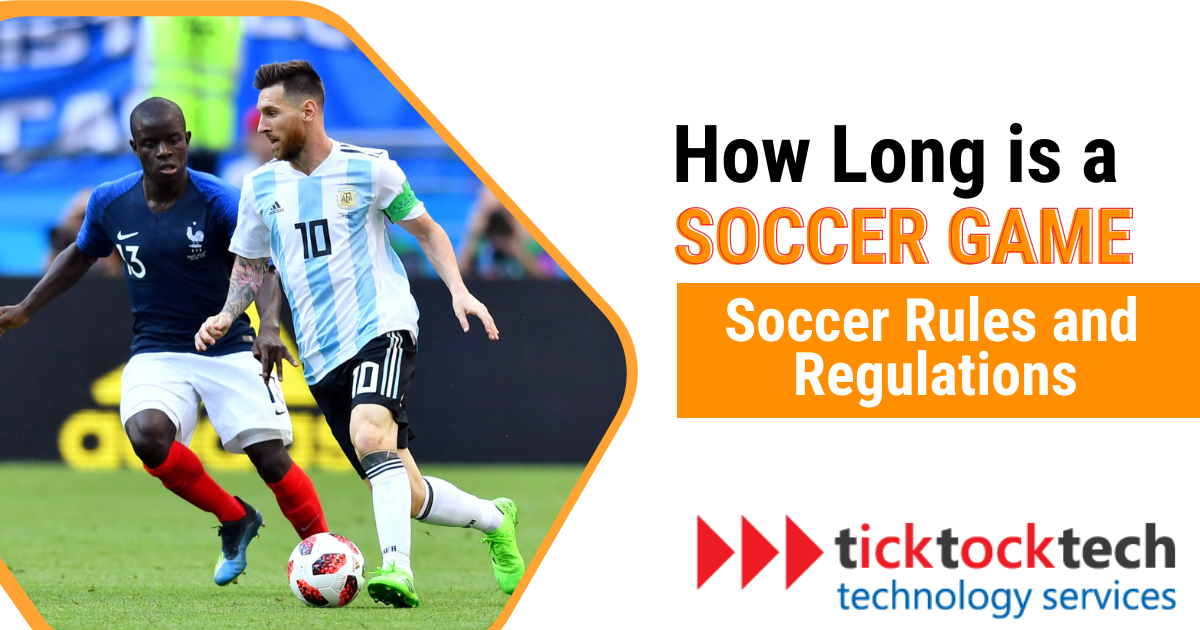Soccer has a long history dating back almost 2,000 years, with its origins in medieval times. It officially gained momentum in the 19th century with the formation of the Football Association (FA) in the United Kingdom, marking the beginning of organized football. In 1904, FIFA, the global governing body, was established, propelling soccer’s remarkable growth worldwide.
Presently, FIFA recognizes 211 associations, reflecting the game’s universal appeal. The FIFA World Cup, which began in 1930, has captivated over 26 billion viewers. It is regarded as the world’s most beloved sporting event.
So, how long is a soccer game, and what rules and regulations govern this popular sport? As you read on, these and other questions will be addressed in this piece.
How Long is a Soccer Game? The Game Format and Duration
The duration of a soccer game depends on the specific competition format in play and any additional time for play stoppages like injuries, VAR checks, and so on.

Keep in mind that added time, also known as injury or stoppage time, is not fixed. The amount of added time depends on how much time was wasted during regular time.
Here’s a breakdown of the typical time frames in different competition formats:
1. Regular matches
A standard soccer game consists of two halves, each lasting 45 minutes, with a 15-minute halftime break, bringing the total duration to 90 minutes. The first and second half can have stoppage time if the match officials deem it necessary.
2. Extra time
Extra time is employed in knockout competitions like the latter stages of World Cup or Cup tournaments. It consists of two equal periods of 15 minutes, with teams switching ends after the first period. In some past competitions, an alternative form of Extra Time called “Sudden Death” or “Golden Goal” was used. The match would end immediately when one team scores, declaring them the winner. The Golden Goal rule was abolished in 2004 to avoid defensive play and provide both teams equal opportunities to win.
During the halftime of extra time, there’s no rest like in regular time; teams quickly discuss tactics and try to regain energy for the final push. If no winner emerges during extra time, the match progresses to a penalty shootout to determine the winner. Throughout history, extra-time play has been infamous for its intensity. As the pressure for a last shot at goals rises, the players’ stamina, skill, and mental resilience become paramount.
3. Penalty shootouts
When high-stakes soccer matches remain undecided after extra time, penalty shootouts are initiated to break the tie. Each team selects five players to take alternating penalty kicks against the opposing goalkeeper, and the match winner is the team that scores the most after the shootout.
Should a team fall behind by such a significant margin that it becomes mathematically impossible for them to catch up even if they win all the remaining penalties, the leading team is declared the winner, and the shootout stops. This rule is commonly known as “clinching” the shootout.
An example occurred in last year’s (2022) quarter-final match between Japan and Croatia. After the first three penalties, Croatia led 3-1. Per the rules, the shootout was supposed to continue, with both teams taking additional penalties until a winner emerged. However, it became clear that even if Japan scored their next penalty and Croatia missed theirs, Croatia would still be leading by two points with no more opportunities for Japan to catch up. Finally, if the score is still tied after the initial five kicks, the shootout progresses to sudden death, with one kick per team until a winner emerges.
Soccer Rules and Regulations – The Number of Players
Soccer matches are played with ten outfield players and one goalkeeper per team, where the goalkeeper wears a uniquely colored jersey for easy identification. On the bench, each team can have seven substitute players. However, only a maximum of 5 (formerly 3) substitutions for three opportunities is allowed during a competitive match. And once a player is substituted, they cannot re-enter the game. A team must have at least 7 outfield players and a goalkeeper to begin or continue a match. These rules are consistent across all competitive games, including the World Cup.
Soccer Rules and Regulations – The Referee
Referees play a crucial role in maintaining order on the field. The center referee holds the primary authority and enforces the official soccer rules throughout the game. Assisting the center referee is two linesman referees on each half of the field and a fourth referee who manages injury time, enforces substitutions, and ensures coaches remain in their designated area.
Line Referees will help with offside, out-of-bounds, fouls, goals, and any other rule obstruction that the central ref might’ve missed. The linesmen will signal the center referee of any obstruction. However, it is up to the Center Referee to stop or let the game continue.
Recently, there has been a notable addition of two extra referees known as video assistant referees(VARs). These refs are responsible for aiding the center referee in making accurate decisions on close calls like straight red cards, possible fouls/handballs in the goal and penalty area, and offsides.
Soccer Rules and Regulations – Start and Restart of Play
In soccer, the game starts with a center kick and is also restarted from the center after each conceded goal and at halftime. If the ball goes out of play on the sidelines, a throw-in is given to the opposing team, taken from where the ball went out. When the attacking team last touches the ball before it crosses the goal line, a goal kick is awarded, and the game resumes with a kick from the goalkeeper’s safety box.

Conversely, if a defender is the last to touch the ball before it goes behind the goal line, a corner kick is awarded to the attacking team. Following official soccer rules, free kicks are given for fouls outside the penalty box or for handling the ball outside the box. The ref usually stops play to award a free kick. An indirect free kick is awarded if the goalkeeper deliberately handles a back-pass from a teammate, and it can only be shot on goal after the second touch on the ball.
Penalty kicks are awarded for handball or fouls inside the penalty box. The referee may call a dropped ball to restart the game in specific situations like injuries, defective equipment, or external factors. The referee drops the ball between two players, with the norm being to return possession to the team that had the ball when the game was stopped.
Soccer Gameplay — Methods of Scoring
During active gameplay and in the absence of rule violations, any player on the field can score goals in soccer. Per official rules, a goal is counted when the entire circumference of the soccer ball crosses the goal line. Players can score using any part of their body except their arms.
Soccer Rules and Regulations — Offside
Offside is signaled by the linesman referee when an attacking player gains an advantage near the goal by positioning. A player is in an offside position if they are nearer to the opponent’s goal line than both the ball and the second-to-last defender (usually a defender or the goalkeeper) when the ball is played to them.
That said, being in an offside position is not an offense by itself. A player becomes offside only if involved in active play by receiving the ball, interfering with an opponent, or gaining an advantage from the offside position. Before the advent of VAR, the assistant referee (linesman) made the offside call based on their judgment of the player’s position during the pass.
However, now that there is VAR technology, offside calls are made with 100% accuracy thanks to state-of-the-art video recording and analysis equipment. VAR referees either ratify linesman offside calls or call the center referee’s attention to calls the linesmen might’ve missed. When offside is called, play is stopped, and an indirect free-kick is awarded to the opposing team from where the offside player committed the offense.
Soccer Gameplay — Fouls and Misconduct
A foul occurs when a player commits an offense against an opponent or the opposing team that the referee deems to be in violation of the rules. Common fouls include tripping, pushing, holding, kicking, and jumping at an opponent. A penalty kick is awarded if the foul is committed inside the box. If otherwise, the offended team gets a free kick. Misconduct by players may result in issuing a yellow card (caution) or a red card (sending-off).
When a player gets a yellow card, the referee cautions them. There’s no second warning. A second yellow is equivalent to a red card, which means the player is off the field. Some fouls, such as violent conduct, spitting, denying a clear goal-scoring opportunity with a deliberate handball or fouling an opposition player as the last man, may result in a straight red card without a prior yellow card. Depending on the severity, players’ misconduct can result in disciplinary action even after the match, leading to suspensions or fines. In modern soccer, VAR technology is used to review potential foul and misconduct decisions to ensure accuracy.
Soccer Gameplay — Free kick
A free kick is given to a team when the opposing side commits a foul outside the box. When defending a free kick, the defending team forms a wall of players to block the ball’s trajectory toward the goal.
There are two types of free kicks – direct and indirect. A direct free kick allows the player to score without the ball touching another player. This is the most common variant. In an indirect free kick, the ball must touch another player before a goal is counted. The most common example of an indirect free-kick is one awarded for an offside decision. Such free-kicks are given within the defensive team’s half, far away from the opposition’s goal, making a direct strike at goal unlikely. You can easily recognize an indirect free-kick because the referee will raise their arm above their head and maintain the gesture until the free-kick is taken. Indirect free-kicks are less frequent in other parts of the pitch as they are typically given for technical infringements that might not be as apparent as fouls, handballs, or other obvious rule violations.
Soccer Gameplay — Penalty kick
When a foul or handball is committed inside the penalty box, the referee awards a penalty. The penalty kick is taken from the penalty spot, 11 meters (approximately 12 yards) away from the goal line. While feinting during the run-up to a penalty kick is allowed, feinting to kick the ball after starting the run-up is prohibited. If a player engages in such prohibited feinting, the referee will caution the player, and the penalty kick must be retaken.
Before the penalty taker shoots the ball, all players must be outside the penalty box. Furthermore, when the shot is taken, the goalie must have at least one leg on his goal line.
If any of these rules are broken, the penalty will be retaken.
Soccer Gameplay — Corner Kick
A corner kick is awarded when the ball crosses the goal line and is last touched by a defender. When a corner kick is awarded, the ball must be placed in the corner area nearest to where it crossed the goal line.
Before taking the kick, the ball must be stationary and will be kicked by a player from the attacking team. During the corner kick, the corner flagpost cannot be disturbed. Moreover, opponents must maintain a distance of at least 9.15 meters (10 yards) from the corner arc until the ball is officially in play.
Frequently Asked Questions
In regular soccer matches, the game is scheduled to last 90 minutes. However, the referee may add additional time due to injuries, substitutions, and other stoppages. This can extend the overall duration of the game beyond the initial 90 minutes.
A soccer match lasts for 90 minutes, divided into two halves of 45 minutes each.
Referencing Opta data at the time of writing. The average duration of a Premier League match during the 2022/23 season is 98 minutes and seven seconds.
The 90 minute rule states that all bets for soccer game outcomes are resolved within 90 minutes of regulation time. Stoppage time is considered part of the regulation time for betting purposes.
After 120 minutes in football, the game proceeds to a penalty shootout. During the penalty shootout, each team takes turns for penalty kicks against the opposing goalkeeper.
Conclusion
Now that you’ve reached this point, we’ve reached the end of this soccer rules and regulations digest. We hope you’ve been able to unlock the key to enjoying the beautiful game to its fullest. We recommend visiting the official FIFA Laws of the Game website to access comprehensive details about soccer rules and regulations. There, you can find a wealth of information to enhance your understanding of soccer’s rules and guidelines.

